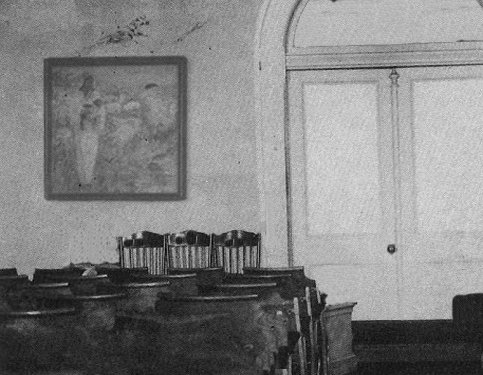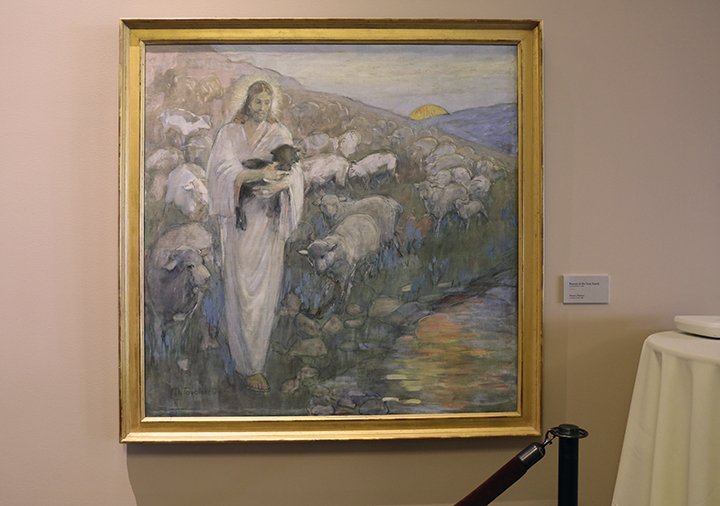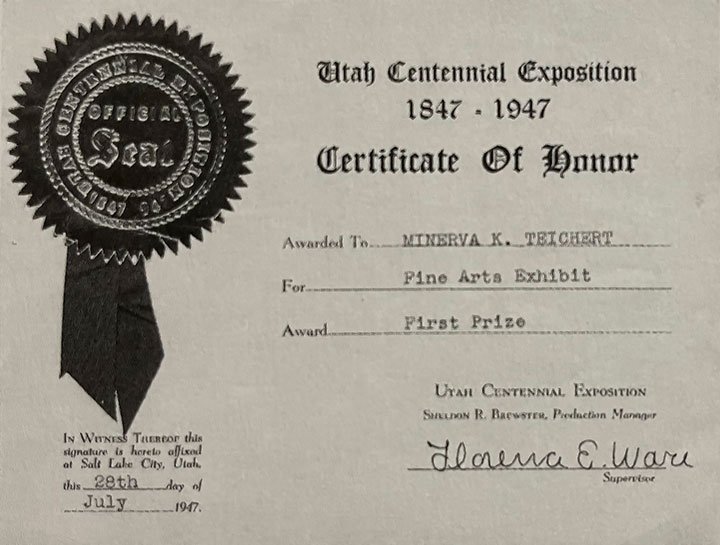
About Minerva Teichert
Minerva Bernetta Kohlhepp Teichert ( August 28, 1888 - May 3, 1976 ) was a beloved American artist made famous by her striking paintings of Mormon history and the western frontier. Her artwork of Latter-Day Saint pioneers, scenes from the Book of Mormon, and depictions of American Indians are highly acclaimed and revered the world over.
Born in 1888, in a small adobe home in Ogden, Utah the second of ten children. Minerva Teichert came from strong, independent women. Her grandmother, Minerva Wade Hickman left her husband “Wild Bill Hickman” who was a body guard for Joseph Smith and Brigham Young and moved her little family of five children into a home in North Ogden. Needing more space for her family, Minerva Hickman hand made her own adobe bricks and enlarged the home. She remained in that home for 52 years, passing away in 1918.
Minerva Teichert Pocatello, Idaho High school graduation photo - with her lifelong friend Eva Kasiska who is seated right in front of Minerva Teichert
The youngest of Bill and Minerva Hickman’s children was Mary Ella Hickman. She eventually married Fredrick Kohlhepp in 1886. Mary and Fred had eight children, the first two (one of which was Minerva Teichert) was born in their grandmother’s adobe brick home. Minerva Kohlhepp was named after her grandmother.
The young Kohlhepp family moved to Idaho, but the hot windy summers proved too much for young Minerva’s eyes, and she soon developed cataracts. She was forced to leave her family in Idaho and move back to North Ogden to live with her grandmother. Minerva was given a set of watercolor paints at 4 years old and claimed her whole life that those watercolors were the beginning of her love of art. Minerva attended school at the yet famous Red Brick School in North Ogden where she graduated from the eighth grade. She made her way back to Idaho eventually to be reunited with her family. At age 14 she traveled to San Francisco as a nanny for an Idaho family. While there, she visited an art museum for the first time in her life. Feeling inspired, she decided to take art classes at the Mark Hopkins Art Institute. Upon her return to Idaho from San Franciso Minerva graduated from High School and Immediately began teaching school to raise money for more art classes.
Minerva Teichert - High School graduation photo - there were only 4 people to graduate from Pocatello, ID High School
At 19 Minerva Teichert traveled off to the booming metropolis of Chicago where she attended the Chicago Art Institute and trained under John Vanderpoel, a master at the school of painting. He often criticized Minevra’s work, in what seemed an unmercifully relentless way, while not doing the same to the other students. One day Minerva became so frustrated she confronted Vanderpoel about it. He replied as to why she, and not the other students were the focus of his critical eye - “Miss Idaho, can it be possible that you don’t understand? They’re not worth it; they will drop out, but you - ah- there is no limit.”
After nearly 5 years in Chicago, at age 24 Minerva finished her courses and returned home to Idaho. She earned money by sketching cadavers for medical schools, illustrating children’s books, and selling sketches of animals. By age 26 she had started classes at the Art Students League in New York. Her instructor, Robert Henri, considered her one of the three best students at the school and gave her a scholarship. He encouraged Minerva to paint what he called “the Mormon experience.” She attended for three years and was then offered a scholarship to study in London, but instead returned home to Idaho to get married.
When she was 29 years old, Minerva Kohlhepp married Herman Teichert on Spetmeber 15, 1917. However, only one year after their wedding, World War 1 broke out and Herman left for battle. Although Minerva traveled with Herman throughout his boot camp training and transfers, she was eventually forced to bid farewell and stayed at home with their new born baby son. During the early years of their marriage, everything was in short supply because of the war, so Minerva Teichert would paint on scraps of wood and paper because there simply wasn’t enough money to buy art supplies. Fortunately, Herman returned home after the war and the couple went on to have four more children. Minerva and Herman spent most of their lives on a ranch in Cokeville, Wyoming.
Minerva Teichert dressed in a costume for a party at the Art Institute of Chicago in 1909 - she studied there for almost four years.
The wild Idaho landscape was the inspiration for many of Minerva Teichert’s paintings. Her works ranged from western American life to themes of her deeply held religious convictions. Minerva often selected subjects that emphasized the role of strong women, and these women feature prominently in many of her works. She was an independent, confident woman and was an outspoken on political and social matters. As her grandniece observed, “Aunt Minerva was feisty, spunky, and was a hundred years before her time, especially about women’s lib and the roles women saw themselves in and what women were capable of doing.” Her legacy of portraying women side-by-side with men in strong heroic scenes has helped in documenting the remarkable role women played not only in the early migrating days of the church, but in the settlement of the western United States.
Minerva Teichert studying art at the Art Institute of Chicago for four years - starting in 1909
Among Minerva Teichert’s most well known paintings is one titled Miracle of the Gulls. Miracle of the Gulls came about when Teichert’s neighbor confided in her that she was heartbroken, but could not afford to send her daughter to BYU. Techert was kind enough to paint Miracle of the Gulls and gift the
This lovely collage shows Minerva Teichert at three different stages of her remarkable life.
money she made from it to her neighbor’s young daughter for her college tuition. Later, when the girl got married, Techiert gave her another painting as a wedding gift. This painting, Queen Esther, ended up being one of Teichert’s most famous and beloved works. Teichert repainted Queen Ester with slight differences (such as three figures in the background as opposed to two in the original) and donated it to Brigham Young University, where it still resides to this day. Queen Ester was also one of three paintings Teichart made in response to the Nazis in Germany. Her son served a mission for the Church of Jesus Christ of Latter-day Saints in Germany in 1938. With antisemitism at terrible levels in the year before World War II began, Teichart’s son wrote letters to his mother expressing his horror regarding the treatment of the Jewish people. Sympathetic to their plight, Teichart painted Queen Esther as a figure of courage and bravery that protected her Jewish people.
Minerva Teichert painted murals - dozens of murals throughout many rooms of the Temples of the Church of Jesus Christ of Latter-days Saints. This beautiful mural is found in the Manti, Temple in Utah.
The earliest known photo of Minerva Teichert Rescue of the Lost Lamb - photo taken Circa 1944 Bonneville Stake Center . The Rescue of the Lost Lamb painting itself was first displayed in the Z.C.M.I. (Zions Cooperative Mercantile Institution) Tiffin Room in a small exhibit on February 28, 1939. Minerva’s daughter records this painting among other works that were on display there. The Tiffin room was a common place where Minerva Teichert art was displayed.
Minerva Teichert in the far left speaking with a group of women in Pocatello, Idaho
The original painting on canvas of Minerva Teichert’s Rescue of the Lost Lamb hangs in the Conference Center of the Church of Jesus Christ of Latter-Day Saints in Salt Lake City, UT.
Birthplace of Minerva Kohlhepp Teichert - Artist of the Rescue of the Lost Lamb and other famous works of art. North Ogden, Utah
Minerva Teichert’s grandparents Bill & Minerva Hickman. Teichert’s mother Mary Ella was not yet born when this photo was taken.
Minerva Teichert and her sister Eda in Idaho
Minerva Teichert performed in many plays and entreatment groups and even as a trick roper in western dances to support herself in art school.
Minerva Teichert’s living room in Cokeville, Wyoming. This photo shows the art that she painted on the upper walls of her home depicting the trees and nearby Snake River around which Minerva Teichert, not only grew up, but painted most of her life. Minerva Teichert Art
Minerva Teichert riding her horse in Wyoming
Minerva Teichert with Robert Henri at the Art Students League in New York City in 1916 - Minerva Teichert is on third row up from the bottom and fourth student from the right.
Minerva Teichert studied art along side Edward Hopper in NYC at the Art Students League. She was encouraged to paint the scenes of “Mormon art history” by fellow artists.
While a student at Art Student League of New York City, Minerva Teichert would visit the Metropolitan Museum Art in New York City as part of her education. This is her Copyist’s Ticket to the museum. A copyist is someone who practices art by mimicking or copying the styles of other artists.
With her dedication to the Mormon church, Teichart was commissioned multiple times for paintings of faith. In 1946 she was commissioned by the church to paint the “World Room” murals in the Manti, Utah Temple. She was the first woman ever asked to paint a mural for a Latter-day Saint temple. The painting was expected to take a year, but Teichart completed it in 23 days. This is even more impressive because at the time of this project, Teichert was a 59 year old grandmother. Near the completion of the mural, Teichart fell from the scaffolding and injured her arm. She left her work for a few hours and went to see a doctor. She returned and immediately started painting again, simply unwilling to stop.
Pocatello, Idaho in the 1920s
Teichert’s striking paintings often reflect her Mormon upbringing and tell stories from her faith. She painted 42 wall-sized murals based on stories from the Book of Mormon. Her desire to paint dozens of scenes from the Mormon scriptures came as an extension of her feeling that she was being “called” to serve her people and her religion with her art.
A distinctive feature of Teichert’s style is her minimal use of detail. Teichert believed that a painting “should be rich in story and backed by a great faith,” often leaving the details of her paintings to the imagination of the beholder. Often, the background is suggested, rather than drawn. This contributes to the style we see in Teichart’s work, often with unfinished edges but wonderfully embellished with colors and patterns. She knew she was finished with a painting when the story had been presented in a way with which she was satisfied; she would say “I’m not going to do anything more with that. That tells the story.” For her, the attitude and position of the figures were far more important to the story than detail. Admirers of Teichert’s painting style say they are drawn to her striking use of color and highlighting. Essential to her narrative was color, which spelled out the story that she wanted to tell. She would say, “the values of color are the only thing that makes things go round, and unless you do that you haven’t accomplished anything.” Techart’s rich color work helps reflect the stories she tells in her art, with a particular focus on red for contrast.
Her husband, Herman, was always a great supporter of her career and her independence. He patiently waited five years to get married while Minerva finished art school. She told a friend, “Herman has always given me free rein to do what I please, so I try to please him, which I could not do if he tried to ‘manage’ me.” Herman was not a member of the church when the couple married, but converted and was baptized in 1933. The couple was sealed the following year in the Logan Utah Temple.
Minerva Teichert Art won first prize in the 1947 Utah Art Exposition.
The true power of Minerva’s strong faith is revealed in the creative conceptualization of more than forty scenes from the Book of Mormon. Her imaginative paintings offer a visual alternative to the more masculine imagery that has previously been used to show these narratives. She gave a unique and beautiful vision of the world of the Book of Mormon. The scriptures were very important to Minerva. She studied them regularly and could quote them for almost any situation. Each of the paintings in the series was supported by scriptural references, which she was careful to list in her notes, together with a description of the scene in her own words.
Minerva Teichert Art of a painting of the Beesley Band
As was very common, the base on Minerva’s canvases was made from a mix of lead paint and linseed oil, which, over time caused her to develop severe lead poisoning. In addition to nausea and abdominal pain she developed optic neuritis which led to a deterioration of her eyesight. She loved painting and continued despite the pain, but later in her life there was an ever-present issue whether her eyesight and health were up to the task. When asked, she simply told her friends and family, “Pray for me. I need it. I want health, eyesight, and inspiration.” Minerva painted into her 70’s when a hip fracture ended her amazing career.
Minerva Teichert magnified her “life’s calling” into thousands of paintings and left us her personal interpretation of the western American life and personal dedication to the gospel she loved so intensely. She carried out this enormous task in addition to being a wife, mother a sister, a daughter and business manager of a large ranch.
Teichert was a dedicated member of the Church of Jesus Christ of Latter-day Saints, raised five children, and achieved a wonderfully successful painting career. She wanted her art to motivate the viewer to greater faith and a greater appreciation for pioneer heritage.























